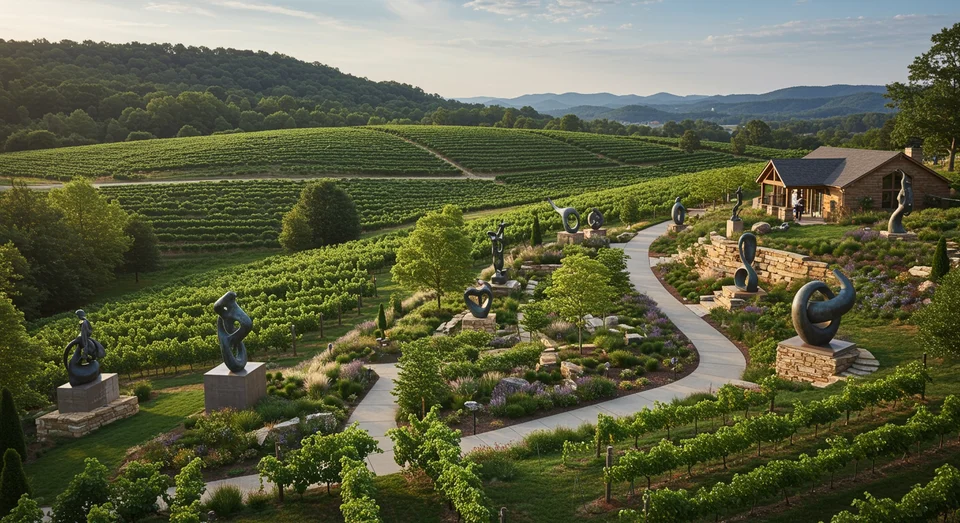
Virginia Tech Students Design Sculpture Garden and Winery
On May 12, 2025, Virginia Tech’s Landscape Architecture Department showcased its Final Master Plan Presentations for the Capital Sculpture Garden & Winery, involving 26 students and special guests. Six interdisciplinary teams presented innovative designs that integrate sculpture, vineyards, and community spaces within a 10-acre site in Loudoun County, aimed at fostering cultural engagement and ecological sustainability. The event highlighted the students’ creativity and received recognition from the Global Humanities Foundation for their contributions.

Student Visions Cultivate a Future Where Art and Nature Intertwine in Loudoun County
Amidst the familiar bustle of final examinations and the celebratory air preceding commencement, Virginia Tech’s campus recently became the setting for a significant academic and creative milestone. The Landscape Architecture Department convened on May 12, 2025, to unveil the culmination of months of dedicated effort: the Final Master Plan Presentations for the ambitious Capital Sculpture Garden & Winery project. This event drew not only faculty and the participating students but also welcomed distinguished guests from the Global Humanities Foundation, whose involvement underscores the project’s profound cultural aspirations.
Twenty-six students, working collaboratively across six distinct interdisciplinary teams, embarked upon the intricate task of conceptualizing a vibrant cultural and ecological destination spanning ten acres within the picturesque expanse of Loudoun County’s renowned wine region. Their challenge involved weaving together disparate elements – the visual power of sculpture, the agrarian rhythms of a working vineyard, and the essential need for welcoming community spaces – into a cohesive and sustainable landscape design. The presentations offered a fascinating glimpse into the varied approaches students took, each team proposing unique ways to harmonize artistic expression with environmental stewardship and public interaction. These designs sought to create a place where visitors might wander among sculptures nestled within vines, gather for events, or simply find quiet contemplation in a setting that celebrates both human creativity and the natural world.
The scope of the Capital Sculpture Garden & Winery extends far beyond merely planting trees and placing art; it envisions a major regional attraction, a place where artistic expression flourishes alongside ecological restoration, fostering deep community engagement. The proposed plans included various themed gardens, each designed to evoke particular moods or tell specific stories, all working towards the overarching goal of promoting peace, harmony, and humanity through the deliberate intersection of art and nature. Such a project speaks to the transformative power of landscape architecture, demonstrating how thoughtful design can shape not just physical space but also influence human experience and connection to the environment. The Global Humanities Foundation, recognizing the depth and potential impact of this student work, presented honorary plaques to several individuals, including dedicated faculty members and a graduate student assistant, acknowledging their vital roles in guiding and supporting this complex undertaking. This recognition highlights the collaborative spirit that animated the project, bridging academic rigor with real-world application and philanthropic vision.
Considering the potential realization of these student-driven concepts, one muses upon the profound impact such a destination could have on the cultural fabric and ecological health of the Loudoun County region. It represents a forward-thinking approach to land use, moving beyond traditional models to create spaces that are multi-functional, aesthetically rich, and environmentally conscious. The integration of a working winery adds an authentic layer of place, grounding the artistic and ecological ambitions in the agricultural heritage of the area. Furthermore, the project’s explicit aim to promote peace, harmony, and humanity through art and nature resonates deeply in a world often marked by division; it offers a tangible vision of how shared spaces, thoughtfully designed, can serve as catalysts for understanding and connection. The work presented by these Virginia Tech students offers not merely blueprints for a garden but hopeful narratives for a future where culture, community, and ecology are inextricably linked, cultivating not just vines and art, but a richer, more harmonious human experience.

